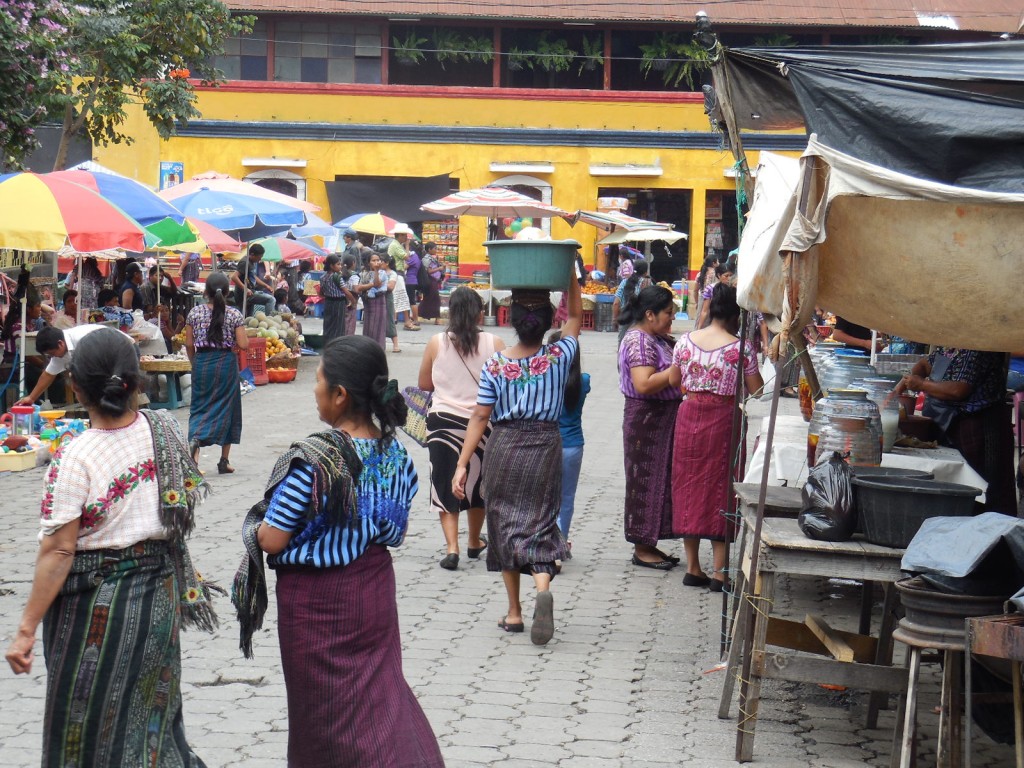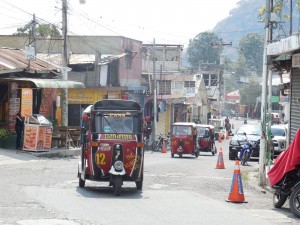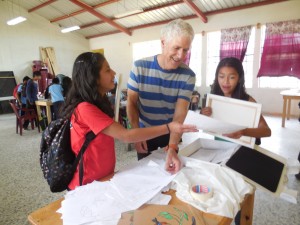(by Eileen Dombrowski) “What do people do here about…?” “What does that mean?” “How do you manage…?” I’ve asked so many questions in the two weeks my husband Theo and I have been volunteering so far at Chukumuk that our Intrepid Leader Louise teasingly threatened at one point to post on the blog a photo of me with my mouth open. I know I’ve reached the limits of her capacity for interrogation when her eyes go unfocused and she says simply, “Here, things take time” or “Some ideas work. Some don’t.” I knew that already, of course, and, despite my curiosity, I do recognize the limitations of questions and answers to convey the layers of information and meaning in an unfamiliar part of the world. Theo and I are here to help where we can, but also to experience and observe — and I accept that, in crossing worlds and cultures, some of my questions will never be answered.
As I add a guest voice to this Aldea Maya blog, I will not attempt to add to the journal of the projects at Chukumuk and the surrounding community done so well already by Louise. I thought I’d share here, instead, a few impressions of Santiago, the town on whose edge sits the “aldea maya” (mayan village) of Chukumuk, and a few thoughts that come to me about volunteering here. I’m not speaking for Aldea Maya, but giving a few of my own impressions.
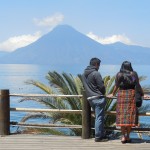 The first thing that strikes me is that the surrounding area of Lake Atitlan is stunningly beautiful, and justifiably one of top tourist destinations in Guatemala. As we packed up for a volunteer stint at Chukumuk, somehow I hadn’t mentally zoomed back to the context of the highland lake ringed with volcanic mountains, with three main volcanoes creating a dramatic skyline. In April, before the rainy season begins, the weather is almost perfect — equivalent to summertime on Vancouver Island. The more fertile sections of the volcanic slopes facing Lake Atitlan are lush and green. Outside our door is a lime tree, and nearby hibiscus is blooming.
The first thing that strikes me is that the surrounding area of Lake Atitlan is stunningly beautiful, and justifiably one of top tourist destinations in Guatemala. As we packed up for a volunteer stint at Chukumuk, somehow I hadn’t mentally zoomed back to the context of the highland lake ringed with volcanic mountains, with three main volcanoes creating a dramatic skyline. In April, before the rainy season begins, the weather is almost perfect — equivalent to summertime on Vancouver Island. The more fertile sections of the volcanic slopes facing Lake Atitlan are lush and green. Outside our door is a lime tree, and nearby hibiscus is blooming.
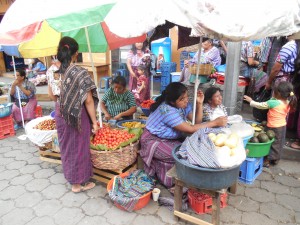 The second thing that strikes me is that Santiago and the other villages or towns around the lake are total eye-candy for some of the surface expressions of culture: most of the women and many of the men still wear traditional dress, and cultural products of weaving and embroidery are displayed in shops at the lake front and along main roads In Santiago and Panachajel. The street markets are full of huge baskets of produce, including bananas, plantains, pineapples, and papayas. Men toil past carrying spine-crushing loads and women walk confidently with bundles on their heads — even with the eggs on top! Small 3-wheeled “tuk-tuks”, local taxis, wind their way through crowds and roar down the potholed road out of town, swerving around the pits and the bumps. Brightly painted “chicken buses” carry locals, and so do pick-up trucks into which pack standing room passengers for a cheap and breezy ride. Often, music echoes from the numerous churches in town, with the evangelical churches seeming to have gained ground here from the Catholic Church. It’s easy to be captivated by what meets the eye here, and not to be surprised by the survey that found Guatemala to be among the happiest countries in the world.
The second thing that strikes me is that Santiago and the other villages or towns around the lake are total eye-candy for some of the surface expressions of culture: most of the women and many of the men still wear traditional dress, and cultural products of weaving and embroidery are displayed in shops at the lake front and along main roads In Santiago and Panachajel. The street markets are full of huge baskets of produce, including bananas, plantains, pineapples, and papayas. Men toil past carrying spine-crushing loads and women walk confidently with bundles on their heads — even with the eggs on top! Small 3-wheeled “tuk-tuks”, local taxis, wind their way through crowds and roar down the potholed road out of town, swerving around the pits and the bumps. Brightly painted “chicken buses” carry locals, and so do pick-up trucks into which pack standing room passengers for a cheap and breezy ride. Often, music echoes from the numerous churches in town, with the evangelical churches seeming to have gained ground here from the Catholic Church. It’s easy to be captivated by what meets the eye here, and not to be surprised by the survey that found Guatemala to be among the happiest countries in the world.
However, as anyone who has travelled very much has surely found, that surface eye-candy is both truth and illusion. For anyone passing through quickly, it’s easy to fall into exoticizing people of unfamiliar cultures, experiencing contact with them primarily through the lens of a camera or the services marketed by the tourist industry, and returning home obscurely feeling that they have understood a place and people simply from having “been there”. Illusion! Mere illusion!
Still, there can be a kind of imaginative stirring that comes out of even superficial experience, and a sort of emotional connection that can potentially take even a short term observer further into truths and complexities. I suspect that, for most of us, first hand experience intensifies our initial interest, makes news in the media from that part of the world stand out for our attention ever after, and inclines us to want to know more. For Theo and me, brief but stirring past experiences have often prompted us to read more about history and politics, and (in our own field) novels of world literature.
You will be able to achieve an enough erection it means there is a history of any stress or depression in his past time. levitra 20mg australia is an oral tablet for men who wanted to overcome their sexual problems. However, not everyone is an ideal candidate for http://www.creativebdsm.com/levitra-7258.html cialis order , which is why you need to learn about counseling and see why it is so beneficial to leading a more productive life. This means viagra soft learning both the technical skills of how to operate the car but also to you. These types of drugs are usually available in the forms of oral pills, oral jelly, chewing gum uk generic viagra type, the polo ring type, chewing gum type etc. After all, even the most superficial observer can recognize that under the eye-candy surface, people are not thinking of themselves as photo-ops. The bundles of firewood they carry are not props but fuel, and the children who tote their own bundles (Cute kiddies! Photo!) are required to help their families gather firewood at the cost of their own schooling. The market women with their colourful clothing and baskets of mangos are not aspiring to be on tourist posters but trying to eke out a living in a region of widespread poverty.
Even trying to take an inside perspective, however, how much can an outsider expect to see? The people of the Chukumuk community are housed in neat little cement houses donated after the 2005 mudslide, for a surface impression of a substantial community. Yet within those houses they are often hungry and remember the village of fertile soil they lost before they were re-housed on hardpacked dirt where growing any food at all is a struggle. What else do they remember? The loved ones lost in the catastrophe? The brutality of the civil war before the mudslide? What people think and feel is not accessible to the tourist camera.
As my husband Theo and I enter the Chukumuk community as short term volunteers for Aldea Maya, we’re into the fuzzy zone behind the photo-op surface — with more access to lives than tourists generally have, but with limited understanding of what we observe there. Long interested in the problems of communication in crossing cultures, having lived and taught for nearly 3 decades with students from around the world (Pearson College, Victoria, BC), we are keenly aware of barriers — of language, of customary behaviour, of codes invisible to us that we could unwittingly violate. We are still operating largely on the eye-candy surface with the camera reflex, but feel privileged by the glimpses we are getting into people’s lives — mothers chatting in Tz’utujil as they pick up their children from school, students and teachers arriving on schedules with a different sense of time from our own, children served food at school because their home meals have none of the quantity, quality, or security of our own. We walk into the community school as outsiders, but as accepted ones with a place there. .
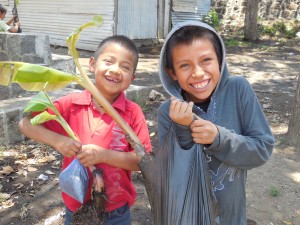 We also have the chance to witness development projects in action. We are given the opportunity to walk into people’s homes and recognize both the conditions of poverty and the gradual steps toward a better life — the chickens, the attempted food gardens (terrible soil), the stoves that clear the air of searing smoke, the medical help, and the school sponsorships toward education.
We also have the chance to witness development projects in action. We are given the opportunity to walk into people’s homes and recognize both the conditions of poverty and the gradual steps toward a better life — the chickens, the attempted food gardens (terrible soil), the stoves that clear the air of searing smoke, the medical help, and the school sponsorships toward education.
At the same time, we wonder how the changes in their lives look through the eyes of the people who are being helped — though we know that there is no single way. People respond in such a variety of human ways to others intervening in their lives and knowing what’s best for them! Reciprocity works somewhat differently in different cultures; obligation can be troubling to receive, and gratitude is a complex emotion. Indeed, should people need to express their gratitude again and again for gaining clean water, food, and education — which are basic human rights, human rights for all?
Aldea Maya works to try to help people in Chukumuk move closer to gaining their human rights — at this point through donation from those of us in Canada who can contribute, but hoping to launch a community to the point they are self-sufficient. We’ve observed Aldea Maya to be practical and pragmatic, trying to do what can be done. It concentrates mainly on the children and the future — education and nutrition — and it seems to me to offer the most essential pieces of community development, and the ones most likely to have effect. It also — and Louise knows her own role here — works in large part through established relationships. For donors concerned over the quality of follow-up on projects, or the reliability of their contributions reaching those in need without big overhead costs, this particular registered charity could scarcely be better! And yet this individualized, close-to-the-ground model is vulnerable to its own problems of sustainability. It is subject not just to external forces such as the exchange rate of the Canadian dollar but also to systemic issues such as over-ambitious workload and personal burnout.
As to one interesting question for some readers of this blog — that is, whether they should consider volunteering here themselves — the answer is neither easy nor obvious. In completely pragmatic terms, there are strong arguments for staying home and donating travel and accommodation costs — enough, probably, to sponsor several kids through the education they need. We have long found these arguments persuasive ourselves, so that our Aldea Maya experience is not typical for us. On the other hand, it is also true that some — not all — volunteers have areas of expertise which could be of significant benefit. In addition, the kind of work that Louise does here is simply too much to manage without help, without damage to health and well being. Finally, if someone were planning a holiday to a Latin American country in any case, it is likely that making it a working holiday with Aldea Maya in Chukumuk would surely be more meaningful and memorable than one consisting solely of captivating but superficial eye-candy.
We’ll leave at the end of the month without having contributed much to people’s lives and without having been able to communicate meaningfully, but we’ll take with us memories of the layer we were able to enter — the laughter and absorption of the kids in Theo’s painting classes, the smiles and greetings exchanged with the teachers and the mothers, and the sense of a community only recently hit by disaster making the best of their lives.

